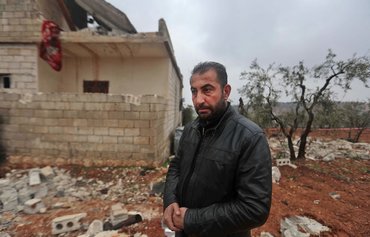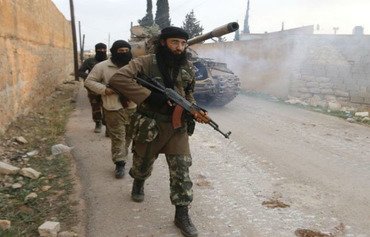In Syria's Idlib province, the relationship between "Islamic State of Iraq and Syria" (ISIS) remnants and al-Qaeda-linked extremist alliance Tahrir al-Sham is symbiotic and complicated, activists told Al-Mashareq.
It is not a coincidence that three top ISIS leaders were killed in the northwestern province where Tahrir al-Sham holds sway, they noted -- yet ISIS has not taken any action against the rival extremist group.
"They all essentially subscribe to the same extremist terrorist ideology," Idlib activist Haytham al-Idlibi said.
"But the successive developments on the ground and defeat of ISIS [in 2019] changed their strategic aims, with Tahrir al-Sham aiming to portray itself as having abandoned extremist ideology," he said.
![Tahrir al-Sham senior official Abu Maria al-Qahtani (L), the group's leader Abu Mohammed al-Jolani (C) and Tahrir al-Sham official Abu Ahmad Zakour are seen here in a photo posted on Twitter on October 16 by French journalist Wassim Nasr, shortly after a visit to an area controlled by Tahrir al-Sham. [Wassim Nasr/Twitter]](/cnmi_di/images/2023/06/12/42543-HTS-officials-Syria-600_384.jpg)
Tahrir al-Sham senior official Abu Maria al-Qahtani (L), the group's leader Abu Mohammed al-Jolani (C) and Tahrir al-Sham official Abu Ahmad Zakour are seen here in a photo posted on Twitter on October 16 by French journalist Wassim Nasr, shortly after a visit to an area controlled by Tahrir al-Sham. [Wassim Nasr/Twitter]
![A member of the White Helmets searches the rubble of the house in which ISIS leader Abu Ibrahim al-Hashemi al-Qurashi was killed in the Syrian town of Atmeh on February 2, 2022. [White Helmets]](/cnmi_di/images/2023/06/12/42544-white-helmets-atmeh-600_384.jpg)
A member of the White Helmets searches the rubble of the house in which ISIS leader Abu Ibrahim al-Hashemi al-Qurashi was killed in the Syrian town of Atmeh on February 2, 2022. [White Helmets]
Some say Tahrir al-Sham is taking advantage of the ISIS presence in Idlib to burnish its own image by comparison, portraying itself as having shifted away from extremist ideology and rebranding as a legitimate political party.
Yet according to local sources and media reports, a good number of ISIS elements and emirs have joined Tahrir al-Sham since ISIS was trounced in Syria and its members were forced into hiding.
These ISIS elements found refuge in the ranks of Tahrir al-Sham, pledged allegiance to the group and sought to influence its agenda from the inside.
While the two groups cleave to a similar brand of extremist ideology and are on some level alike, there are marked differences between them, along with rival agendas and deep-seated mistrust, activists said.
"Despite the entry of a large number of ISIS elements and emirs into Tahrir al-Sham's areas of influence with its consent, it sensed danger from some of them," al-Idlibi said.
A few dozen ISIS fighters and emirs moved to Idlib after the group's territorial defeat in Syria in 2019, Idlib activist Musab Assaf told Al-Mashareq.
A large number of them joined Tahrir al-Sham and other extremist or opposition factions, rising to prominent and sensitive positions in "record time", he said.
'Existential danger'
"After ISIS's defeat, Tahrir al-Sham leader Abu Mohammed al-Jolani sensed an existential danger to himself and his group," strategy analyst and terror group specialist Yahya Mohammed Ali said.
"So he tried to portray himself as non-extremist, even in the clothes he wears," signaling to the West that he alone can eliminate the extremist groups present in Idlib province, Ali explained.
Yet "Tahrir al-Sham is failing to administer the area it controls", Ali said.
"The poverty rate is very high, there are very few job opportunities and the residents of this area and its camps depend almost entirely on aid provided by humanitarian, medical and social organisations."
"The conditions there are no different from those in regime-controlled areas," he added, noting that many areas under the control of Tahrir al-Sham are witnessing tensions and demonstrations denouncing the extremist alliance.
With regard to the presence of ISIS elements and emirs in Idlib, Ali pointed out that "it is impossible for this to happen without Tahrir al-Sham's approval".
"It is not a coincidence that three of the four ISIS caliphs were killed in the Idlib region," he added, referring to the deaths of Abu Bakr al-Baghdadi, Abu Ibrahim al-Hashemi al-Qurashi and Abu Hasan al-Hashemi al-Qurashi.
It is likely that Tahrir al-Sham deliberately exposed the location of their hideouts, or that the ISIS leaders were sacrificed to boost Tahrir al-Sham's credentials with the West and convince the West to accept it as a non-extremist group.
Unlike ISIS, he said, it can be argued that Tahrir al-Sham has succeeded in avoiding an all-out war waged against it.
"Despite the vastness of the areas it controlled, the large number of fighters it recruited and the influx of money into its coffers, ISIS could not hold off the US-led international coalition against terrorism," he said.

![Tahrir al-Sham elements are seen here on March 18 at the extremist alliance's headquarters in the Syrian city of Idlib. [Tahrir al-Sham's General Security Service Facebook page]](/cnmi_di/images/2023/06/12/42542-Tahrir-al-Sham-600_384.jpg)






